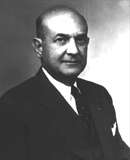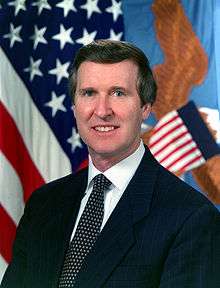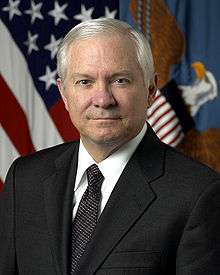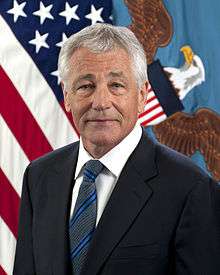United States Secretary of Defense
| Secretary of Defense of the United States of America | |
|---|---|
|
Seal of the Department of Defense[1] | |
|
| |
|
United States Department of Defense Office of the Secretary of Defense | |
| Style | Mr. Secretary |
| Member of |
Cabinet National Security Council |
| Reports to | The President |
| Seat | The Pentagon, Arlington County, Virginia, U.S. |
| Appointer |
The President with Senate advice and consent |
| Term length | No fixed term |
| Constituting instrument |
10 U.S.C. § 113 50 U.S.C. § 401 |
| Precursor |
Secretary of War and Secretary of the Navy |
| Inaugural holder | James Forrestal[3] |
| Formation | September 19, 1947 |
| Succession |
Sixth in the presidential line of succession.[4] |
| Deputy |
Deputy Secretary of Defense (principal deputy) Chairman of the Joint Chiefs of Staff (military deputy) |
| Salary | $203,700 annually[5] (Executive Schedule I)[6] |
| Website | www.defense.gov |
The Secretary of Defense (SecDef) is the leader and chief executive officer of the Department of Defense, an Executive Department of the Government of the United States of America.[7][8][9] The Secretary of Defense's power over the United States military is second only to that of the President.[10] This position corresponds to what is generally known as a Defense Minister in many other countries.[11] The Secretary of Defense is appointed by the President with the advice and consent of the Senate, and is by custom a member of the Cabinet and by law a member of the National Security Council.[12]
Secretary of Defense is a statutory office, and the general provision in 10 U.S.C. § 113 provides that the Secretary of Defense has "authority, direction and control over the Department of Defense", and is further designated by the same statute as "the principal assistant to the President in all matters relating to the Department of Defense."[13] Ensuring civilian control of the military, an individual may not be appointed as Secretary of Defense within seven years after relief from active duty as a commissioned officer of a regular (i.e., non-reserve) component of an armed force.[14]
The Secretary of Defense is in the chain of command and exercises command and control, for both operational and administrative purposes subject only to the orders of the President, over all Department of Defense forces: the Army, Marine Corps, Navy, and Air Force. This is also extended to the United States Coast Guard during any period of time in which its command and control is transferred to the Department of Defense.[15][16][17][18][19] Only the Secretary of Defense (or the President) can authorize the transfer of operational control of forces between the three Military Departments (the departments of the Army, Navy, and Air Force) and the nine Combatant Commands (Africa Command, Central Command, European Command, Northern Command, Pacific Command, Southern Command, Special Operations Command, Strategic Command, Transportation Command).[15] Because the Office of Secretary of Defense is vested with legal powers which exceed those of any commissioned officer, and is second only to the President in the military hierarchy, it has sometimes unofficially been referred to as a de facto "deputy commander-in-chief".[20][21][22] The Chairman of the Joint Chiefs of Staff is the principal military adviser to the Secretary of Defense and the President, and while the Chairman may assist the Secretary and President in their command functions, the Chairman is not in the chain of command.[23]
The Secretary of Defense, Secretary of State, the Attorney General, and the Secretary of the Treasury are generally regarded as the four most important cabinet officials because of the importance of their departments.[24]
The current Secretary of Defense is Ashton Carter, who was confirmed as the 25th Secretary of Defense on February 12, 2015,[25] and assumed office on February 17, 2015.[26]
History

The Army, Navy, and Marine Corps were established in 1775, in concurrence with the American Revolution. The War Department, headed by the Secretary of War, was created by Act of Congress in 1789 and was responsible for both the Army and Navy until the founding of a separate Department of the Navy in 1798.
Based on the experiences of World War II, proposals were soon made on how to more effectively manage the large combined military establishment. The Army generally favored centralization while the Navy had institutional preferences for decentralization and the status quo. The resulting National Security Act of 1947 was largely a compromise between these divergent viewpoints. The Act merged the Department of War (which was renamed as the Department of the Army) with the Department of the Navy to form the National Military Establishment (NME), presided over by the Secretary of Defense. The Act also separated the Army Air Forces (known before and very early in the war as the Army Air Corps) from the Department of the Army to become its own branch of service, the Department of the Air Force. (Each branch was provided with its own Secretary.) At first, each of the service secretaries maintained quasi-cabinet status. The first Secretary of Defense, James Forrestal, who in his previous capacity as Secretary of the Navy had opposed creation of the new position, found it difficult to exercise authority over the other branches with the limited powers his office had at the time. To address this and other problems, the National Security Act was amended in 1949 to further consolidate the national defense structure in order to reduce interservice rivalry, directly subordinate the Secretaries of the Army, the Navy and the Air Force to the Secretary of Defense in the chain of command, and rename the National Military Establishment as the Department of Defense, making it one Executive Department. The position of the Deputy Secretary of Defense, the number two position in the department, was also created at this time.
The general trend since 1949 has been to further centralize management in the Department of Defense, elevating the status and authorities of civilian OSD appointees and defense-wide organizations at the expense of the military departments and the services within them. The last major revision of the statutory framework concerning the position was done in the Goldwater–Nichols Department of Defense Reorganization Act of 1986. In particular, it elevated the status of joint service for commissioned officers, making it in practice a requirement before appointments to general officer and flag officer grades could be made.
Powers and functions
The Secretary of War [now Secretary of Defense] is the regular constitutional organ of the President for the administration of the military establishment of the nation; and rules and orders publicly promulgated through him must be received as the acts of the executive, and as such, be binding upon all within the sphere of his legal and constitutional authority. Such regulations cannot be questioned or denied because they may be thought unwise or mistaken. .
Nor is it necessary for the Secretary of War [now Secretary of Defense] in promulgating such rules or orders to state that they emanate from the President, for the presumption is that the Secretary is acting with the President's approbation and under his direction.

The Secretary of Defense, appointed by the President with the advice and consent of the Senate, is by federal law (10 U.S.C. § 113) the head of the Department of Defense, "the principal assistant to the President in all matters relating to Department of Defense", and has "authority, direction and control over the Department of Defense". Because the Constitution vests all military authority in Congress and the President, the statutory authority of the Secretary of Defense is derived from their constitutional authorities. Since it is impractical for either Congress or the President to participate in every piece of Department of Defense affairs, the Secretary of Defense, and the Secretary's subordinate officials generally exercise military authority.
As the head of DoD, all officials, employees and service members are "under" the Secretary of Defense. Some of those high-ranking officials, civil and military (outside of OSD and the Joint Staff) are: the Secretary of the Army, Secretary of the Navy, and Secretary of the Air Force, Army Chief of Staff, Commandant of the Marine Corps, Chief of Naval Operations, and Air Force Chief of Staff, Chief of the National Guard Bureau and the Combatant Commanders of the Combatant Commands. All of these high-ranking positions, civil and military, require Senate confirmation.
The Department of Defense is composed of the Office of the Secretary of Defense (OSD), the Joint Chiefs of Staff (JCS) and the Joint Staff (JS), Office of the Inspector General (DODIG), the Combatant Commands, the Military Departments (Department of the Army (DA), Department of the Navy (DON) & Department of the Air Force (DAF)), the Defense Agencies and DoD Field Activities, the National Guard Bureau (NGB), and such other offices, agencies, activities, organizations, and commands established or designated by law, or by the President or by the Secretary of Defense.
Department of Defense Directive 5100.01 describes the organizational relationships within the Department, and is the foundational issuance for delineating the major functions of the Department. The latest version, signed by former Secretary of Defense Robert Gates in December 2010, is the first major re-write since 1987.[27][28]
Office of the Secretary of Defense
The Secretary's principally civilian staff element is called the Office of the Secretary of Defense (OSD) and is composed of the Deputy Secretary of Defense (DEPSECDEF) and five Under Secretaries of Defense in the fields of Acquisition, Technology & Logistics, Comptroller/Chief Financial Officer, Intelligence, Personnel & Readiness, and Policy; several Assistant Secretaries of Defense; other directors and the staffs under them.
The name of the principally military staff organization, organized under the Chairman of the Joint Chiefs of Staff, is the Joint Staff (JS).
Awards and decorations
The Defense Distinguished Service Medal (DDSM), the Defense Superior Service Medal (DSSM), the Defense Meritorious Service Medal (DMSM), the Joint Service Commendation Medal (JSCM) and the Joint Service Achievement Medal (JSAM) are awarded, to military personnel for service in joint duty assignments, in the name of the Secretary of Defense. In addition, there is the Joint Meritorious Unit Award (JMUA), which is the only ribbon (as in non-medal) and unit award issued to joint DoD activities, also issued in the name of the Secretary of Defense.
The DDSM is analogous to the distinguished services medals issued by the military departments (i.e. Army Distinguished Service Medal, Navy Distinguished Service Medal & Air Force Distinguished Service Medal), the DSSM corresponds to the Legion of Merit, the DMSM to the Meritorious Service Medal, the JSCM to the service commendation medals, and the JSAM to the achievement medals issued by the services. While the approval authority for DSSM, DMSM, JSCM, JSAM and JMUA is delegated to inferior DoD officials: the DDSM can only be awarded by the Secretary of Defense.
Recommendations for the Medal of Honor (MOH), formally endorsed in writing by the Secretary of the Military Department concerned and the Chairman of the Joint Chiefs of Staff, are processed through the Under Secretary of Defense for Personnel and Readiness, and such recommendations be must approved by the Secretary of Defense before it can be handed over to the President, who is the final approval authority for the MOH, although it is awarded in the name of Congress.
The Secretary of Defense, with the concurrence of the Secretary of State, is the approval authority for the acceptance and wear of NATO medals issued by the Secretary General of NATO and offered to the U.S. Permanent Representative to NATO in recognition of U.S. Service members who meet the eligibility criteria specified by NATO.[29]
Congressional committees
As the head of the department, the Secretary of Defense is the chief witness for the congressional committees with oversight responsibilities over the Department of Defense. The most important committees, with respect to the entire department, are the two authorizing committees, the Senate Armed Services Committee (SASC) and the House Armed Services Committee (HASC), and the two appropriations committees, the Senate Appropriations Committee and the House Appropriations Committee.
For the DoD intelligence programs the Senate Select Committee on Intelligence and the House Permanent Select Committee on Intelligence have the principal oversight role.
National Security Council
The Secretary of Defense is a statutory member of the National Security Council.[30] As one of the principals, the Secretary along with the Vice President, Secretary of State and the Assistant to the President for National Security Affairs participates in biweekly Principals Committee (PC) meetings, preparing and coordinating issues before they are brought before full NSC sessions chaired by the President.
Role in the military justice system
The Secretary is one of only five or six civilians — the others being the President, the three "service secretaries" (the Secretary of the Army, Secretary of the Navy, and Secretary of the Air Force), and the Secretary of Homeland Security (when the United States Coast Guard is under the United States Department of Homeland Security and has not been transferred to the Department of the Navy under the Department of Defense) — authorized to act as convening authority in the military justice system for General Courts-Martial (10 U.S.C. § 822: article 22, UCMJ), Special Courts-Martial (10 U.S.C. § 823: article 23, UCMJ), and Summary Courts-Martial (10 U.S.C. § 824: article 24 UCMJ).
Amenities
Salary
Secretary of Defense is a Level I position of the Executive Schedule,[6] and thus earns a salary of $203,700 per year as of January 2015.
List of Secretaries of Defense
The longest-serving Secretary of Defense is Robert McNamara, who served for a total of 2,595 days. Combining his two non-sequential services as Secretary of Defense, the second longest serving is Donald Rumsfeld, who served just ten days fewer than McNamara. The shortest-serving Secretary of Defense is Elliot Richardson, who was quickly moved to US Attorney General after 114 days due to resignations during the Watergate Scandal (not counting Deputy Secretary of Defense William P. Clements and William Howard Taft IV, who each served a few weeks as temporary/acting Secretary of Defense).
- Parties
- Status
| No. | Portrait | Name | State of Residence | Took Office | Left Office | Days served | President serving under | |
|---|---|---|---|---|---|---|---|---|
| 1 |  |
James V. Forrestal | New York | September 19, 1947 | March 19, 1949 | 558 | Harry S Truman | |
| 2 |  |
Louis A. Johnson | West Virginia | March 28, 1949 | September 19, 1950 | 540 | ||
| 3 |  |
George C. Marshall | Pennsylvania | September 19, 1950 | September 19, 1951 | 365 | ||
| 4 |  |
Robert A. Lovett | New York | September 19, 1951 | January 20, 1953 | 491 | ||
| 5 |  |
Charles E. Wilson | Michigan | January 20, 1953 | October 8, 1957 | 1,722 | Dwight D. Eisenhower | |
| 6 |  |
Neil H. McElroy | Ohio | October 9, 1957 | December 1, 1959 | 783 | ||
| 7 |  |
Thomas S. Gates, Jr. | Pennsylvania | December 2, 1959 | January 20, 1961 | 415 | ||
| 8 |  |
Robert S. McNamara | Michigan | January 21, 1961 | February 29, 1968 | 2,595 | John F. Kennedy | |
| Lyndon B. Johnson | ||||||||
| 9 |  |
Clark M. Clifford | Maryland | March 1, 1968 | January 20, 1969 | 326 | ||
| 10 | |
Melvin R. Laird | Wisconsin | January 22, 1969 | January 29, 1973 | 1,469 | Richard Nixon | |
| 11 |  |
Elliot L. Richardson | Massachusetts | January 30, 1973 | May 24, 1973 | 114 | ||
| – |  |
William P. Clements (acting) |
Texas | May 24, 1973 | July 2, 1973 | 39 | ||
| 12 |  |
James R. Schlesinger | Virginia | July 2, 1973 | November 19, 1975 | 403 | ||
| 467 (870 total) |
Gerald Ford | |||||||
| 13 |  |
Donald Rumsfeld | Illinois | November 20, 1975 | January 20, 1977 | 427 | ||
| 14 |  |
Harold Brown | California | January 21, 1977 | January 20, 1981 | 1,460 | Jimmy Carter | |
| 15 |  |
Caspar Weinberger | California | January 21, 1981 | November 23, 1987 | 2,497 | Ronald Reagan | |
| 16 | Frank Carlucci | Virginia | November 23, 1987 | January 20, 1989 | 424 | |||
| – | William Howard Taft IV (acting) |
Ohio | January 20, 1989 | March 20, 1989 | 59 | George H. W. Bush | ||
| 17 |  |
Richard B. Cheney | Wyoming | March 21, 1989 | January 20, 1993 | 1,402 | ||
| 18 |  |
Leslie Aspin | Wisconsin | January 21, 1993 | February 3, 1994 | 378 | Bill Clinton | |
| 19 |  |
William J. Perry | Pennsylvania | February 3, 1994 | January 24, 1997 | 1,085 | ||
| 20 |  |
William S. Cohen | Maine | January 24, 1997 | January 20, 2001 | 1,457 | ||
| 21 |  |
Donald Rumsfeld | Illinois | January 20, 2001 | December 18, 2006 | 2,158 | George W. Bush | |
| 22 |  |
Robert M. Gates | Texas | December 18, 2006 | July 1, 2011 | 764 | ||
| 879 (1,643 total) |
Barack Obama | |||||||
| 23 |  |
Leon Panetta | California | July 1, 2011 | February 27, 2013 | 608 | ||
| 24 |  |
Chuck Hagel | Nebraska | February 27, 2013 | February 17, 2015 | 720 | ||
| 25 |  |
Ashton Carter | Massachusetts | February 17, 2015 | Incumbent | 351 | ||
Succession
Presidential succession
The Secretary of Defense is sixth in the presidential line of succession, following the Secretary of the Treasury and preceding the Attorney General.[31]
Secretary of Defense succession
In Executive Order 13533 of March 1, 2010, President Barack Obama modified the line of succession regarding who would act as Secretary of Defense in the event of a vacancy or incapacitation, thus reversing the changes made by President George W. Bush in Executive Order 13394 as to the relative positions of the Secretaries of the Military Departments. All of the officials in the line of succession are civilians appointed by the President with the advice and consent of the Senate:
Living former Secretaries of Defense
As of June 2015, there are ten living former Secretaries of Defense, the oldest being Melvin Laird (1969–1973, born 1922). The most recent Secretary of Defense to die was James R. Schlesinger (1973–1975), on March 27, 2014.
| Name | Term of office | Date of birth (and age) |
|---|---|---|
| Melvin Laird | 1969–1973 | September 1, 1922 |
| Donald Rumsfeld | 1975–1977, 2001–2006 | July 9, 1932 |
| Harold Brown | 1977–1981 | September 19, 1927 |
| Frank Carlucci | 1987–1989 | October 18, 1930 |
| Dick Cheney | 1989–1993 | January 30, 1941 |
| William Perry | 1994–1997 | October 11, 1927 |
| William Cohen | 1997–2001 | August 28, 1940 |
| Robert Gates | 2006–2011 | September 25, 1943 |
| Leon Panetta | 2011–2013 | June 28, 1938 |
| Chuck Hagel | 2013–2015 | October 4, 1946 |
See also
|
|
|
References
Footnotes
- ↑ Trask & Goldberg: p. 177.
- ↑ http://www.tioh.hqda.pentagon.mil/UniformedServices/Flags/Pos_Colors_DoD.aspx, accessed on 2012-01-04.
- ↑ Trask & Goldberg: pp. 57–60.
- ↑ 3 U.S.C. § 19
- ↑ "Pay & Leave: Salaries & Wages". Salary Table No. 2015-EX. United States Office of Personnel Management. 2015-01-01. Retrieved 2016-01-04.
- 1 2 5 U.S.C. § 5312.
- ↑ 10 U.S.C. § 113.
- ↑ DoDD 5100.1: Enclosure 2: a
- ↑ 5 U.S.C. § 101.
- ↑ Trask & Goldberg: p.11
- ↑ http://www.nato.int/cps/en/SID-C0FDE451-36F2483B/natolive/nato_countries.htm, accessed on 2012-01-04.
- ↑ 50 U.S.C. § 402.
- ↑ 10 U.S.C. § 113
- ↑ The National Security Act of 1947 originally required an interval of ten years after relief from active duty, which was reduced to seven years by Sec. 903(a) of the 2008 National Defense Authorization Act. In 1950 Congress passed special legislation (Pub. Law 81-788) to allow George C. Marshall to serve as Secretary of Defense while remaining a commissioned officer on the active list of the Army (Army regulations kept all five-star generals on active duty for life), but warned:
It is hereby expressed as the intent of the Congress that the authority granted by this Act is not to be construed as approval by the Congress of continuing appointments of military men to the office of Secretary of Defense in the future. It is hereby expressed as the sense of the Congress that after General Marshall leaves the office of Secretary of Defense, no additional appointments of military men to that office shall be approved.
See Defenselink bio, retrieved 8/2/2010; and Marshall Foundation bio, retrieved 8/2/2010. - 1 2 10 U.S.C. § 162
- ↑ Joint Publication 1: II-9, II-10 & II-11.
- ↑ 10 U.S.C. § 3011
- ↑ 10 U.S.C. § 5011
- ↑ 10 U.S.C. § 8011
- ↑ Trask & Goldberg: pp.11 & 52
- ↑ Cohen: p.231.
- ↑ http://www.americanprogress.org/issues/2006/10/rumsfeld.html, accessed on 2012-01-06.
- ↑ 10 U.S.C. § 152
- ↑ Cabinets and Counselors: The President and the Executive Branch (1997). Congressional Quarterly. p. 87.
- ↑
- ↑ http://www.startribune.com/politics/national/292209061.html
- ↑ Department of Defense Directive 5100.01 Functions of the Department of Defense and Its Major Components
- ↑ DoDD 5100.1: p.1.
- ↑ DoDM 1348.33, Vol 3: p.39 (Enclosure 3)
- ↑ 50 U.S.C. § 402
- ↑ 3 U.S.C. § 19.
Sources
Federal law
Directives, regulations and manuals
- Department of Defense Directive 5100.1: Functions of the Department of Defense and Its Major Components (PDF). Department of Defense Directive. Washington, D.C.: U.S. Department of Defense. 2010-12-21.
- Department of Defense Manual 1348.33, Volume 1: Manual of Military Decorations and Awards: General Information, Medal of Honor, and Defense/Joint Decorations and Awards (PDF). Department of Defense Manual. Washington, D.C.: U.S. Department of Defense. 2013-03-07.
- Department of Defense Manual 1348.33, Volume 2: Manual of Military Decorations and Awards: General Information, Medal of Honor, and Defense/Joint Decorations and Awards (PDF). Department of Defense Manual. Washington, D.C.: U.S. Department of Defense. 2013-05-31.
- Department of Defense Manual 1348.33, Volume 3: Manual of Military Decorations and Awards: General Information, Medal of Honor, and Defense/Joint Decorations and Awards (PDF). Department of Defense Manual. Washington, D.C.: U.S. Department of Defense. 2010-11-23.
- Joint Publication 1 – Doctrine for the Armed Forces of the United States (PDF). Joint Publications. Washington, D.C.: U.S. Department of Defense. 2013-03-25.
- Joint Publication 1-04 – Legal Support to Military Operations (PDF). Joint Publications. Washington, D.C.: U.S. Department of Defense. 2011-08-17.
Further reading
- Cohen, Eliot A. (2003). Supreme Command: soldiers, statesmen and leadership in wartime. New York: Anchor Books. ISBN 978-1-4000-3404-8.
- Cole, Alice C.; Goldberg, Alfred; Tucker, Samuel A.; et al., eds. (1978). The Department of Defense: Documents on Establishment and Organization 1944–1978 (PDF). Washington, D.C.: Historical Office, Office of the Secretary of Defense/U.S. Government Printing Office.
- Huntington, Samuel P. (1957). The Soldier and the State. Cambridge, Massachusetts: The Belknap Press of Harvard University Press. ISBN 0-674-81736-2.
- King, Archibald (1960) [1949]. Command of the Army (PDF). Military Affairs. Charlottesville, Virginia: The Judge Advocate General's School, U.S. Army.
- Mahan, Erin R., and Jeffrey A. Larsen, eds. (2012) “Evolution of the Secretary of Defense in the Era of Massive Retaliation: Charles Wilson, Neil McElroy, and Thomas Gates, 1953–1961,” Cold War Foreign Policy Series: Special Study 3 (September 2012), vii–41.
- Stevenson, Charles A. (2006). SECDEF: the nearly impossible job of Secretary of Defense. Dulles, Virginia: Potomac Books. ISBN 1-57488-794-7.
- Trask, Roger R.; Goldberg, Alfred (1997). The Department of Defense 1997-1947: Organization and Leaders (PDF). Washington, D.C.: Historical Office, Office of the Secretary of Defense/U.S. Government Printing Office. ISBN 0-16-049163-0.
- The Department of Defense Key Officials 1947–2013 (PDF). Washington, D.C.: Historical Office, Office of the Secretary of Defense. 2013.
Primary historical sources
- Cheney, Dick; Cheney, Liz (2011). In My Time: A Personal and Political Memoir. New York: Simon & Schuster. ISBN 978-1-4391-7619-1.
- Rumsfeld, Donald (2011). Known and Unknown: A Memoir. New York: Sentinel. ISBN 978-1-59523-067-6.
Online sources
- "Department of Defense Directive 5100.01 Functions of the Department of Defense and Its Major Components". Office of the Secretary Defense, Director of Administration and Management, Directorate for Organizational & Management Planning. Retrieved 13 June 2013.
External links
| Wikimedia Commons has media related to United States Secretary of Defense. |
| United States presidential line of succession | ||
|---|---|---|
| Preceded by Secretary of the Treasury Jack Lew |
6th in line | Succeeded by Attorney General Loretta Lynch |
| ||||||||||
| ||||||||
| |||||||||||||||||||||||||||||||||||||||||||||||||||||||||||||||||||||||||||||||||||||||||||||||||||||||||||||||||
| ||||||||||||||||||||||||
| ||||||||||||||||||||||||||||||||||||||||||||||||||||||||||||||||||||||||||||||||||||
| ||||||||||


